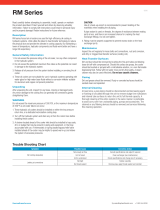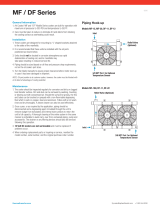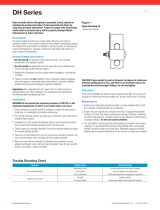Page is loading ...

Audi RS6Audi RS6
Audi RS6Audi RS6
Audi RS6
Self Study Program
Course Number 991303

Audi of America, Inc.
Service Training
Printed in the U.S.A.
Printed 6/2003
©2003 Audi of America, Inc.
All rights reserved. All information contained in this
manual is based on the latest product information
available at the time of printing and is subject to the
copyright and other intellectual property rights of
Audi of America, Inc., its affiliated companies and
its licensors. All rights are reserved to make changes
at any time without notice. No part of this document
may be reproduced, stored in a retrieval system, or
transmitted in any form or by any means, electronic,
mechanical, photocopying, recording or otherwise,
nor may these materials be modified or reposted to
other sites without the prior expressed written
permission of the publisher.
All requests for permission to copy and redistribute
information should be referred to Audi of America,
Inc.
Always check Technical Bulletins and the Audi
Worldwide Repair Information System for
information that may supersede any information
included in this booklet.
Trademarks: All brand names and product names
used in this manual are trade names, service marks,
trademarks, or registered trademarks; and are the
property of their respective owners.

Overview..................................................................................................................... Page 1
Body ........................................................................................................................... Page 3
Engine and Transmission ............................................................................................ Page 8
Running Gear ............................................................................................................ Page 38
Air Conditioning System .......................................................................................... Page 47
Other Features .......................................................................................................... Page 48
Technical Data .......................................................................................................... Page 50
The Self Study Program provides you with information regarding designs and functions.
The Self Study Program is not a Repair Manual.
For maintenance and repair work, always refer to the current service repair information.
Table of Contents
i
NOTE CAUTION


Overview
1
The Audi RS6
The arrival of the Audi RS6 has given a
whole new meaning to the term “vehicle
dynamics.” As was the case with the Audi
RS4, the new top model in the Audi A6
Series was conceived by Audi’s star
designers at quattro GmbH and developed
in conjunction with Audi AG.
The quattro four-wheel drive Audi RS6 has a
4.2-liter V8 engine with two turbochargers,
five valves per cylinder and twin charge air
cooling.
With 450 hp, 415 lb/ft of torque, Tiptronic 5-
speed automatic transmission, and a sport
suspension, the RS6 has the agility of a
sports car, accelerating from 0 to 60 mph in
4.6 seconds (0-100 km/h in 4.9 seconds).
Adding to the sporty feel and appearance of
the RS6 are the Formula 1-style Tiptronic
shift “paddles” on the steering wheel.

Overview
2
Standard features include leather, heated
Recaro sports seats, carbon fiber interior
trim, Symphony II radio with Bose sound
system, and Xenon high intensity
headlights.
The Audi RS6 is not intended for
trailer operation or the installation of
an auxiliary heater.
Audi RS6 is the first vehicle to use the
hydraulic active running gear system
Dynamic Ride Control (DRC). This damper
system eliminates much of the body roll and
pitch encountered on cornering. A brake
system with disc diameters of 365 mm
(front) and 335 mm (rear) ensures balanced
deceleration.
With its high-grade materials, the exclusive
interior equipment of the Audi RS6
combines a sporty atmosphere and
excellent comfort.

Body
3
Sill Panels
The new sill cover panel is bolted to the
underbody as well as to the front and rear
wings and is attached by means of plastic
plugs to the top of the sill.
The side dirt deflectors forming part of the
Audi A6 basic equipment are not fitted.
The upper fastening elements of the sill
panel trim are concealed by the sill molding
with the RS6 emblem.
Rail section to
accommodate sill molding

Body
4
Raising the vehicle at other points
could damage body components,
including sill panels.
Jacking Points
The positions for jack and hoist application
are marked on each sill panel. The reinforced
parts of the body designed to safely
withstand lifting forces are only to be found
in this marked area.
Mark on sill panel indicates body
reinforcement point for applying jack

Body
5
Front End
The front end has been modified in the area
of the fog lights and charge-air inlet cover
panel. The screw connection for the front
towing eye is located directly behind this
cover panel.
Engine Compartment
Noise Insulation
To help muffle sound, a noise insulation
plate is fitted on the underside of the engine
compartment. The three center vents play an
essential part in providing the large amount
of additional cooling air required for the
engine and transmission.
Cooling air for oil cooler
Honeycomb
cover panel
The flow of air is specifically directed to
units subject to high thermal load. The two
side vents enable the turbocharger cooling
air to escape.
Turbocharger
cooling air
outlet
Turbocharger
cooling air
outlet
Inlet for gearbox cooling air

Body
6
Engine Compartment
The coolant expansion tank and brake fluid
reservoir have been relocated to the plenum
chamber.
Positioning pins in air cleaner housing
The levels in the expansion tank and
reservoir can be checked in the usual
manner after removing the two covers.
Oil filler neck
The engine oil filler neck is located
on the left side beneath the front
engine compartment cover.
Release or engage the two cover
locking pins by tapping them
briefly. The cover can be tilted and
lifted out.
MAX
MAX
MIN
MIN
Coolant
expansion tank
Brake fluid
reservoir
Locking pin
(cap open)

Body
7
Rear Spoiler
A rear spoiler is standard on the RS6. The
spoiler is attached to the trunk lid using four
bolts. To achieve an even form fit on the
trunk lid contour, it is secured by means of
all-around double-sided bonding.
4 bolted joints
All-around bond

Engine and Transmission
8
Audi RS6 Engine
4.2L Biturbo V8
The engine was developed using the V8
engine of the Audi S6 as a base.
The goal was to create an engine that could
achieve high torque levels at low engine
speeds.

Engine and Transmission
9
BCY
Biturbo V8, 4.2-liter, 5-valve,
90º, 4-stroke, gasoline engine
450 hp at 5700 - 6400 rpm
415 lb/ft of torque at
1950 - 5600 rpm
6700 rpm
3.32 in. (84.5 mm)
3.66 in. (93 mm)
255 cu. in. (4172 cc)
9.8 : 1
1 - 5 - 4 - 8 - 6 - 3 - 7 - 2
507 lbs.
Motronic ME7.1.1 with
electronic multi-point sequential
fuel injection system
Two air-gap-insulated tubular
manifolds, two underhood
primary catalytic converters,
heated oxygen sensors
Premium Plus unleaded
recommended for
maximum performance
Engine Technical Data
Code letters:
Type:
Power:
Torque:
Max. engine speed:
Bore:
Stroke:
Displacement:
Compression ratio:
Firing order:
Engine Weight:
Fuel Injection:
Emission system:
Fuel:
A sticker indicating the engine code
letters is attached to the toothed
belt guard (refer to Repair Manual).
This sticker must be reattached if
the toothed belt guard is replaced as
part of repair work.
0
65
135
205
275
345
415
485
0
35
70
105
140
175
210
245
280
315
350
385
420
455
490
2000 4000 6000 8000
torque (lb/ft)
Engine Speed (rpm)
power (hp)

Engine and Transmission
10
Crankshaft Group
Crankshaft
The crankshaft uses a standard shaft
modified in the flange area.
Because engine speed and inertia forces are
relatively low (greater compressive force),
the V8 crankshaft is fitted with a doubly
reinforced 10-hole flange drive plate.
4 x oil drain
holes in area
of oil scraper
ring
Crankshaft with
10-hole flange
Pistons
The piston skirt is provided with a Ferrostan
II bearing surface coating.
The piston design is such that cylinder bank
assignment is not necessary.
The compression ratio is reduced to ε = 9.8.
Valves
In the course of reworking the necessary
valve throats, the diameters of the two
exhaust valves per cylinder and the
corresponding seat rings were reduced to
d = 27 mm.
Securing pin Starter ring gear
with sender wheel
Drive plate
reinforced with
10-hole flange

Engine and Transmission
11
Cylinder Head
Cylinder Head Gasket
In line with the engine concept, the cylinder
head made of a new Alumisil alloy is fitted
with a four-layer sealing system at the
cylinder block and crankcase. The increased
power level with charged engines produces
higher firing pressures.
The gasket materials are an important factor
in the structural integrity of the engine. Their
different profile heights permit optimum
force distribution within the components
and extend the service life of the sealing
beads. As a central element, the gaskets are
made up of beaded, elastomercoated spring
steel layers.
Cylinder head with cover
Cylinder head gasket
Cylinder block and crankcase
4-layer cylinder head gasket
4-layer structure of sealing system

Engine and Transmission
12
Cylinder Head Cooling
The light alloy cylinder head with five valves
(three inlet and two exhaust valves per
cylinder) has been adapted to meet the
more exacting demands of the V8 biturbo
engine through the use of different
materials.
In the area of the combustion chambers and
exhaust ports, the V8 engine has been fitted
with an optimized water jacket for improved
heat dissipation. This also necessitated
appropriate adaptation of the openings in
the multi-layer cyinder head gasket for the
passage of coolant.
Because of the differences in water
routing, there are specific cylinder
head gaskets for each bank.
Marked areas show the optimized water
openings in the cylinder head gasket
Water jacket in
exhaust area

Engine and Transmission
13
Oil Flow
The oil flow of the V8 biturbo is similar in
design and operation to the V8 5V engine.
Two turbochargers for increased power add
to the number of temperature-intensive
components in the oil circuit. A design
modification at the oil pump enables the
cut-off pressure in the oil circuit to be
increased, ensuring constant supply and the
proper cooling of all engine components.
Oil temperature is controlled by two
separate coolers:
1st circuit — by the familiar oil/water heat
exhanger in the oil filter module
2nd circuit — with the air-to-oil cooler
located at the front end beneath the radiator
Turbocharger
New oil pump
Two-part
sump
Dark Green =
Oil circulation under pressure
Light Green =
Oil circulation without pressure
Turbocharger
Oil filter module
with integrated
oil/water heat
exchanger

Engine and Transmission
14
Air Supply
Two new, large air cleaner elements are
used to cope with the increased air
requirements of the turbo engine.
Advantages of charge-air cooling:
• Improved efficiency thanks to greater density of cooled air
• Lower temperatures, reduced knock tendency
Compressor inlet
from air cleaner
Turbocharger
Pressure
pipes
From charge-air cooler
Right charge-air cooler
Air intake elbow
Hoses to
charge-air
cooler
Upper collector
Lower collector
Cold air is drawn in through two separate
inlets in the front end above the radiator.

Engine and Transmission
15
After passing through the mass air flow
sensors, the flow of air is routed through a
piping system to the water-cooled
turbochargers. Vibration-damping elements
at the air cleaner outlet and pressure pipe
connections ensure acoustic isolation of
the entire system. From the turbocharger,
the hot compressed air is routed to the
charge-air coolers and then through the
newly developed air collector pipe at the
front of the engine. The intake manifold is
responsible for distribution to the cylinders.
To engine
Air collector pipe
From charge-air cooler
Cold air inlet
Left charge-air cooler

Engine and Transmission
16
Crankcase Breather
The crankcase breather consists of the
following:
• Pressure limiting valve
• Non-return valve
• Tubing with distributor
For more details on design and
operation of the crankcase breather,
EVAP system, secondary air,
charge-air control and recirculation
control, refer to SSP 941903 —
2.7L V6 Biturbo.
Connection at cylinder block
and crankcase/oil separator
Connection at
intake manifold
Cylinder head
cover connection
Pressure limiting valve
Non-return valve
Connection upstream
of compressor
Cylinder head
cover connection
Pressure limiting valve
/



